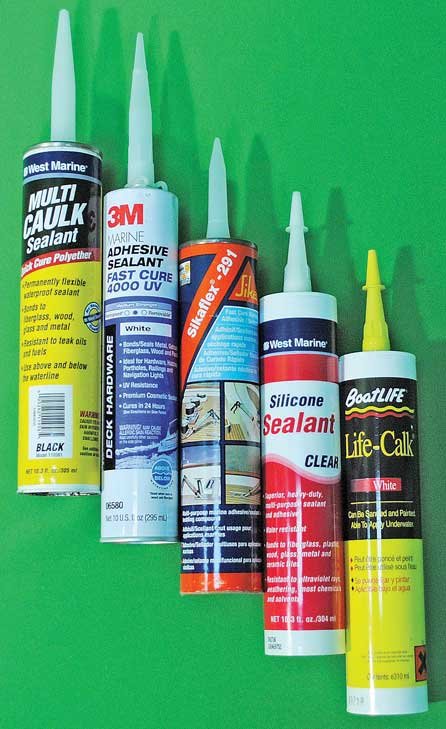
Boat Sealants
Based on an article by Don Casey
Perfect technique can't make up for the wrong sealant. If you really want to stop that leak, start by getting the sealant right.
Doing the job right starts with using the right sealant. Picking the wrong sealant can cause a host of problems from early failure to not being able to free a fitting if necessary. Some sealants will never bond to plastic; others deteriorate when exposed to chemicals. Choose the wrong sealant and, at best, you'll be doing this job again next year. At worst, you'll have to destroy some of your deck to free a cleat.
Unfortunately, the manufacturers don't make it easy to figure out what sealant will work best for your particular project. Well-stocked marine-supply stores have four types of sealant on their shelves — polyurethane, polysulfide, polyether, and silicone — most of which say only "marine sealant" or maybe "adhesive sealant." An additional sealant worthy of consideration will not even be on the shelf. Rather than a gooey paste applied with a nozzle, butyl tape is a sticky solid pressed into position (see sidebar).
The best-known modern marine sealant, 3M 5200, a polyurethane, has a well-deserved reputation for unsurpassed strength and tenacity that makes it the go-to sealant. But, as you'll see below, for many applications, including bedding deck hardware, another product would be a wiser choice. Formulated for cohesive failure (the sealant fails before the bond releases), 3M 5200's tensile strength of 700 psi (pounds per square inch; the force necessary to pull the bonded pieces apart) means it can take more than 5 1/2 tons of force to separate a 4-inch stanchion base from the deck. 3M 5200 is, in fact, a construction adhesive, not a sealant. A construction adhesive bonds two surfaces with a near-permanent bond; a sealant keeps water out. Strength is not the first requirement for a good sealant to bed deck hardware held in place by mechanical fasteners. Understanding what really matters will help you to pick the best alternative.
What Really Matters
A good marine sealant for bedding deck fittings must be waterproof, of course, but it must also be flexible, UV resistant, and, ideally, chemical resistant (fuel, bleach, and other solvents do find their way on deck occasionally). It should not be so strong that the deck hardware can't be removed if necessary, or so tenacious that it leaves a residue that prevents other sealants from adhering. From an aesthetic perspective, it should resist dirt and not age in an unsightly way.
If you can't find butyl tape or have more faith in a curing sealant, Boatlife Life-Calk polysulfide, applied as described in the article, "Re-Bedding Deck Fittings", will be your best choice for bedding metal and wood (but not ABS or Lexan) because of its excellent chemical resistance and emphasis on sealing rather than bonding. The polyethers accommodate movement better than the polysulfides and have better UV resistance, and 3M 4000 UV is even compatible with plastic. But the stronger bond will be problematic if disassembly is required.
Sikaflex 295 UV polyurethane is another alternative to polysulfide. A combination of superior UV resistance, liberal elongation, and compatibility with plastic (in concert with a primer) makes this a versatile sealant. Its advantage over 3M 4000 UV and over all of the other polyurethane products is its lower strength, which makes future disassembly/removal easier. You can, of course, use any of the other polyurethanes, but unless your intent is to bond rather than seal, these are choices you may come to regret.
The alternative for sealing framed windows, if you skip butyl tape, is silicone sealant. Bonded windows require a structural glazing silicone such as Dow 795 (or Sikaflex 295 UV polyurethane protected with a special primer). Beyond portlights and specialized uses, you'll save yourself grief if you keep silicone sealant away from the deck and hull.
Don't just pick up any tube of marine sealant from your favorite chandlery and set to work. If you want to make sure that leak doesn't come back, take the time to select the best sealant for the job. While it may not be as much fun as playing with drills and bolts, choosing the right sealant is every bit as important as the proper technique to make that fitting watertight
There's much to like about butyl tape for bedding deck hardware. It takes a bit longer to apply, but it's easy, relatively mess-free, and the job is finished as soon as the nuts are tightened — no waiting for the sealant to cure. It's the best choice for framed portlights, but should be avoided where it may come into contact with chemicals. It does not cure, so butyl tape properly installed should remain watertight for decades, yet it's also the easiest to dismantle.